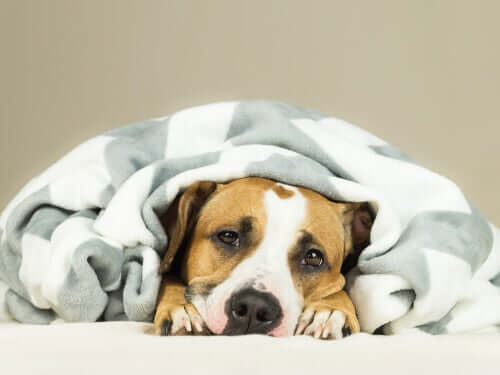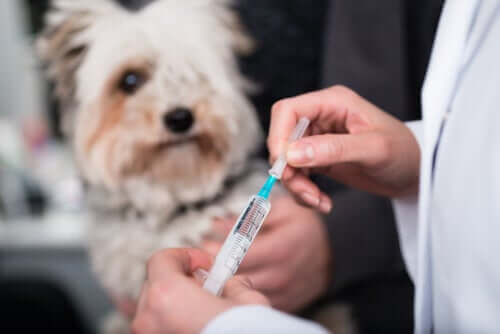Helpful Tips for Preventing Colds in Dogs


Written and verified by the vet Juan Pedro Vazquez Espeso
Winter’s here for half of our planet, and, with it, snow, low temperatures, and, of course, the common cold. Almost as typical as hats and scarves are tissues and hot bowls of chicken soup to relieve uncomfortable symptoms. And, unfortunately, our pets aren’t exempt when the winter weather arrives. And that’s why we want to take this opportunity to offer helpful tips on how to prevent colds in dogs.
What’s a cold?
A cold is a complex of illnesses that affect the respiratory system of many animals, including dogs. This includes viruses like CAV-1 y CAV-2 from the Adenoviridae family, herpesvirus, and bacterias like Bordetella bronchiseptica and Streptococcus. Other pathogens may also play a part as, when one of them starts the infection, it’s common for others to show up to the party. However, the culprits we mentioned are the most common and those that produce the most symptoms.
What are the symptoms of colds in dogs?

Since colds in dogs affect their respiratory systems, the most common symptoms have to do with the same. However, colds can also affect other organs, like the eyes. The most frequent symptoms are the following:
- Fairly frequent coughing with variable intensity. In the veterinary world, many equate the noise to that of a honking goose. The cough may be dry or moist–that is, with phlegm. Situations like exercise and nervousness can exacerbate symptoms. Dogs always cough when they have a cold. So, if a dog isn’t coughing, then it doesn’t have a cold. Therefore, it’s the most important and typical symptom of colds in dogs. As for the rest of the symptoms, they may or may not be present.
- Fever, from mild to moderate or moderately high. Animals may develop fluctuating hypothermia. They usually don’t reach 104ºF.
- Nasal secretions. Depending on the severity of the infection, mucus may be clear and liquid or thicker with color.
- Apathy and lethargy, especially when fever is present.
- Ocular secretions.
- Breathlessness, which is more noticeable than that which occurs during intense exercise.
Are colds in dogs a serious risk to their health?
In general, no. Just as in humans, the process is usually self-limiting. Colds usually go away on their own without any major complications. However, there are at-risk populations such as very young puppies, older dogs, and animals with a compromised immune system. Dogs with another concomitant illness may also decline in the case of a clinical cold. In these animals, treatment must be more careful and exhaustive.
Treatment of colds in dogs consists of the administration of antibiotic medications in order to control bacterial infections. It’s also important to provide symptom relief through the administration of antitussives or nebulizations in order to hydrate respiratory mucus.
Tips for preventing colds in dogs

In order to prevent colds in dogs, the best tips to keep in mind are the following:
- Keep your dog’s vaccine calendar up to date: This is the best way to prevent colds in dogs. The vaccines that are included in the vaccination plan include the live vaccine strains for the principle pathogen agents that cause colds. Therefore, it’s always best to follow your veterinarian’s advice and immunize your dog as indicated.
- Vaccinate against parainfluenza: The vaccines for the parainfluenza virus–one of the illnesses involved in colds in dogs–requires special mention. A vaccine exists against this virus, but it’s not part of the habitual immunization calendar. Therefore, veterinarians usually recommend it for dogs that live in places like nursing homes or hotels where the risk of contagion is higher. It’s common for this vaccine to be a prerequisite in these cases.
- Protect dogs from the cold: This is especially important when it comes to short-haired dogs and small breeds. It’s best to bundle them up before taking them out in the winter in order to mitigate the effects of cold weather. Waterproof jackets are the best option, especially when it comes to snow or rain.
- Avoid turning the heat up too high in your home: You need to take into account the fact that dogs have a coat of hair that serves as a permanent jacket. That doesn’t mean you can’t turn on the furnace, but maintain a moderate temperature in your house in order to avoid abrupt temperature changes when you go outdoors.
- Keep your dog’s throat moist: This is especially true if you’re going for a long walk. It’s best to take along a bit of water for your dog to drink every once in a while. If your dog’s throat stays moist, it’s harder for pathogens to proliferate there.
In conclusion…
We’re sure that you’ll find these tips to be useful when it comes to preventing colds in dogs. Be sure to put them into practice to keep your animals healthy and happy this winter.
This text is provided for informational purposes only and does not replace consultation with a professional. If in doubt, consult your specialist.